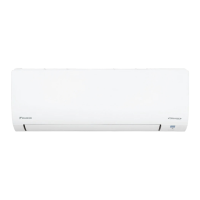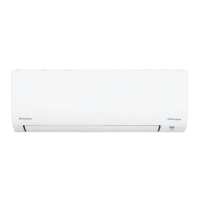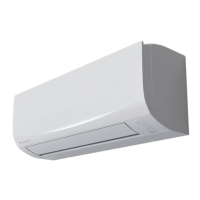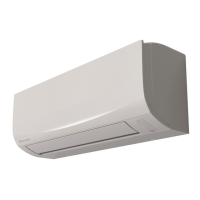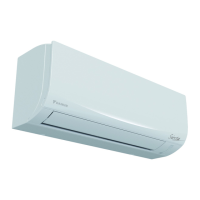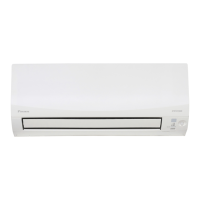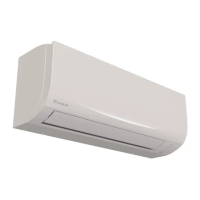Do you have a question about the Daikin FTXF20E5V1B and is the answer not in the manual?
Explains the purpose and content of the installer reference guide, including warnings and information.
Provides a summary of the guide's chapters and their content, outlining what each section covers.
Discusses the language of the original documentation and emphasizes following precautions carefully.
Explains the various warning symbols used in the manual and their meanings for safety.
Provides general guidance and warnings specifically for installers to follow during operation.
Offers general advice for installers, including contacting the dealer if unsure about installation.
Details requirements and forbidden locations for installation to ensure safety and proper function.
Specifies required space for installation, ventilation, and unit placement.
Guides on calculating the minimum required floor area based on refrigerant charge.
Discusses refrigerant handling safety, including risks of explosion and pressure.
Covers crucial safety precautions for electrical wiring and connections.
Emphasizes that installation must comply with legislation and be done by authorized personnel.
Advises checking unit weight support, providing service space, and avoiding contact with walls.
Warns against brazing/welding for R32 and provides guidance on joining parts.
Details safety measures for charging refrigerant, including flammability and protective gear.
Highlights safety checks like proper earthing and cover installation before power-on.
Warns about test operation dangers and avoiding contact with moving parts.
Advises switching off power, waiting before touching parts, and avoiding rinsing the unit.
Introduces what to do after the unit is delivered, covering unpacking and handling.
Focuses on the indoor unit, specifically its unpacking and initial handling.
Provides instructions and visual guidance on how to unpack the indoor unit safely.
Details the process of removing accessories like the mounting plate from the unit package.
Illustrates and labels the main components of the air conditioning system.
Specifies the safe and effective temperature and humidity ranges for cooling, heating, and drying.
Guides on choosing an appropriate installation location and preparing the site.
Lists specific requirements for the indoor unit's installation site.
Outlines steps for accessing internal components by opening the indoor unit.
Provides step-by-step instructions for safely removing the front panel of the indoor unit.
Explains the procedure for correctly reattaching the front panel after access.
Details the process for safely removing the front grille, often requiring protective gear.
Instructs on how to properly reattach the front grille after it has been removed.
Guides on how to open and remove the cover for the electrical wiring box.
Explains the steps to open the service cover for internal unit access.
Covers the physical installation of the indoor unit onto the mounting plate.
Highlights important safety and procedural precautions before installing the unit.
Provides detailed steps for correctly mounting the plate on the wall.
Details the process and precautions for drilling the wall hole for pipes.
Explains how to remove the pipe port cover to connect piping.
Covers guidelines for connecting and installing the drain piping for condensation.
Outlines the essential requirements and materials for refrigerant piping.
Specifies material, diameter, and quality standards for refrigerant piping.
Details the material and thickness requirements for insulating refrigerant piping.
Introduces the process of connecting the refrigerant pipes between units.
Describes the typical workflow and guidelines for connecting refrigerant pipes.
Lists crucial precautions and cross-references to other safety sections.
Provides detailed guidelines for connecting pipes, including flare nut tightening and protection.
Offers advice on proper pipe bending techniques to avoid damage.
Explains the correct procedure for flaring pipe ends for secure connections.
Details the process of connecting the refrigerant pipes to the indoor unit and insulating them.
Introduces the process of connecting the electrical wiring to the system.
Outlines the typical workflow for electrical wiring connections.
Lists essential safety warnings and precautions for electrical connections.
Provides instructions on wire preparation methods like twisting and using terminals.
Lists standard wiring components, their specifications, and tightening torques.
Details the step-by-step process of connecting the electrical wiring to the indoor unit.
Explains how to connect optional HA system components like remote controllers.
Details how to properly insulate the various pipes and cables together.
Guides on correctly routing the pipes through the wall hole and sealing it.
Explains the final steps to securely attach the indoor unit to the mounting plate.
Describes how to set different addresses for multiple indoor units in the same room.
Introduces the process of commissioning and testing the installed system.
Provides a checklist of items to verify before starting the system's test run.
Explains how to conduct a test run to ensure proper operation of all functions.
Details the specific procedure for performing a test run in winter conditions.
Guides on explaining operation, maintenance, and providing documentation to the end-user.
Advises on proper disposal methods, emphasizing compliance with legislation and specialized facilities.
Indicates where to find the wiring diagram and its availability.
Explains the symbols and color codes used in the wiring diagrams.
Defines key terms used throughout the installer reference guide.
| Brand | Daikin |
|---|---|
| Model | FTXF20E5V1B |
| Category | Air Conditioner |
| Language | English |
